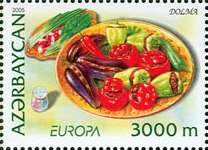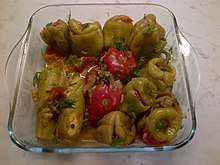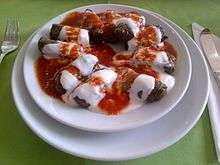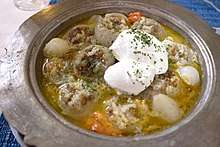Dolma
Dolma is a family of stuffed dishes found in the Balkans, South Caucasus, Central Asia and the Middle East. Common vegetables for stuffing are tomato, pepper, onion, zucchini, eggplant and pointed gourd. Stuffed cabbage rolls and vine leaves are also very popular, which sometimes also called sarma (from Turkish sarmak (wrap)). Meat dolmas are generally served warm, often with tahini or avgolemono sauce. Dolmas prepared with olive oil and stuffed with rice are generally served cold with a garlic-yogurt sauce.
 Azerbaijani dolmas with vine leaves (top); dolmas with eggplant, tomato, and pepper (middle); a stamp issued by Azerbaijan's Postal Service (bottom) | |
| Course | Appetizer or main dish |
|---|---|
| Place of origin | Middle East |
| Region or state | Central Asia, Eastern Europe, South Caucasus, Middle East, Western Asia |
| Serving temperature | Cold or hot |
| Main ingredients | Stuffed peppers, vine leaves, rice, gourd, eggplant |
| Variations | Partial |
| Dolma making and sharing tradition, a marker of cultural identity | |
|---|---|
| Country | Azerbaijan |
| Reference | 1188 |
| Region | Europe and North America |
| Inscription history | |
| Inscription | 2017 (12th session) |
Other traditions of stuffed vegetables are found in other parts of the world, such as Italian ripieni,[1] Mexican chile relleno, Cantonese tofu-stuffed vegetables,[2] etc.
In 2017, dolma making in Azerbaijan was included into the UNESCO Intangible Cultural Heritage Lists. The tradition is present throughout the Republic of Azerbaijan, and is perceived as a central culinary practice in all of its regions.[3]
Names and etymology
The word dolma is of Turkish origin from the word dolmak (to fill).[4] The dish is found in the cuisines of the Turkic countries, the Balkans, South Caucasus, Central Asia, Middle East and Arabia. The word varies between Turkic dialects called dolama in Turkmen and tulma in the Tatar language. The word dolma most likely comes from Ottoman palace cuisine.
History
Dolma have been a part of Middle Eastern cuisine for centuries.[5] Though the word dolma itself most likely has its roots in the cuisine of the Ottoman Topkapı Palace, stuffed vegetables are attested to in pre-Ottoman Arabic cookbooks that include recipes like eggplants stuffed with meat. Likewise, in Ancient Greece, fig leaf stuffed with sweetened cheese was called thrion.[6]
The Iranian variety has been traced to at least the 17th century and in the 19th century Naser al-Din Shah Qajar's chef records several varieties including stuffed vine leaves, cabbage leaves, cucumbers, eggplants, apples, and quinces. The recorded stuffings included ground meat, sauteed mint, rice and saffron.[7]
Distribution
It is one of the most popular and traditional dishes in Iraqi cuisine, and considered a national dish of Iraq, consumed by all ethnic groups in Iraq.[8][9][10] It includes a version of stuffed cabbage leaves, onions in aubergines cooked in tomato sauce.[11] Syrians, Lebanese, Iraqis and Iranians have been making stuffed vine leaves for centuries. Over time, regional variations developed.
Stuffed vegetables are also common in Greek cuisine, called gemista or tsounidis, dorma in India[12] and mahshi in Arabic.[6]
In the Persian Gulf, basmati rice is preferred, and the flavor of the stuffing may be enhanced using tomatoes, onions and cumin.[5] Muslim families often serve dolma as part of the iftar meal during Ramadan and during the Eid al-Fitr celebrations that mark the end of the holy month. Assyrians prepare meatless dolmas for Lent. Large pots of dolma are prepared during the Norouz festival.[13]

Dolma are part of cuisine of the Sephardic Jews as well.[14] There are some variations in Jewish family dishes that are not found in other versions. Iraqi Jewish families had a version of dolma with sweet and sour flavors that were not found in other versions.[15] During winter months cabbage was a staple food for peasants in Persia and the Ottoman Empire, and it spread to the Balkans as well. Jews in the Ottoman Empire used locally grown grape leaves and adopted the Turkish names of the dish. Jews in Eastern Europe prepared variations of stuffed cabbage rolls with kosher meat—this dish is called golubtsy in Russian, holubtsi in Ukrainian, gołąbki in Polish and holishkes or teibel in Yiddish. As meat was expensive, rice was sometimes mixed in with the meat. Jews in Europe would sometimes substitute barley, bread or kasha for the rice.[16]
Dolma in India is limited within Bengali cuisine. The Bengali dish potoler dorma or stuffed pointed gourd is the most common example of all.[17]
Variants
There are many varieties of the zeytinyağlı (with olive oil) and sağyağlı (with clarified butter) dolmas. The zeytinyağlı dolmas are usually stuffed with rice and served cold, but variations with meat based fillings are served warm.[18][19]
Wrapped vine leaves
The origins of stuffed vine leaves are unknown. They are known as dolme in Iran, dolmades in Greece, tolma in Armenia, and yerba in Syria.[20] Some Israelis may use leaves picked from the local mulberry trees.[21]

Stuffed vine leaves without meat are sometimes called yalancı dolma, which means "fake dolma" in Turkish.[22] Vişneli yalancı dolması is a variation of stuffed vine leaves where the rice is seasoned with cinnamon, allspice and mint. The dolmas are slowly cooked together with morello cherries (vişne), and plums may be used also.[23] An Israeli recipe has a meat-filled variant served in a pomegranate sauce with dried cherries.[24]
In Persian cuisine basuts dolma is a dish of cabbage rolls stuffed with beans and tart fruits. In Armenia, it is called Lenten Dolma or Pasuts Tolma (պասուց տոլմա). It is wrapped with cabbage leaves, and stuffed with red beans, garbanzo beans, lentils, cracked wheat, tomato paste, onion and many spices and flavorings.[25] Pasuts tolma is made of seven different grains – chickpea, bean, lentil, cracked wheat, pea, rice and maize. All the grains are boiled. This dolma is called pasuts (fast day) because the Christian New Year features the fast days, which end on Easter day. Armenian cooks sometimes use rose hip syrup to flavor stuffed cabbage rolls.[26] Some Jewish families eat stuffed cabbage on Simchat Torah.[16] There is a Turkish variation with a chestnut-and-rice-based filling.[27]
Egyptians call this main course mahshi (also spelled mashi or mashy). It is stuffed vine leaves[28] but traditionally, cabbage is used in the winter and vine leaves are used in the summer.[29] According to Anthony Khatchaturian, a member of the Armenian community in Kolkata, India, the Bengali dish potoler dorma (stuffed gourd) was adapted from meat-stuffed vine leaves.[30]
Vegetables
Mülebbes dolma is a historic recipe from the Ottoman era.[31] Halep dolması—named for Aleppo—is a dish of eggplants stuffed with a meat and rice filling that is flavored with spices and either sour plum flavoring syrup or lemon juice.[32][33] Şalgam dolma are stuffed Russian turnips.[34][35]

Soğan dolması ("soğan" meaning "onion" in Turkish), or stuffed onions, are a traditional dish in Bosnia, considered the specialty of Mostar. Ingredients include onions, minced beef, rice, oil, tomato purée, paprika, vinegar or sour cream, strained yogurt (locally known as kiselo mlijeko, literally "sour milk"), black pepper, salt and spices. After the onion's skin is removed, the larger, external, layers (leaves) of onion bulbs are used as containers, so called "shirts" (Old Turk. "dolama(n)" for a special kind of Ottoman robe) for the meat stuffing. The remaining part of onion is also used, mixed with the meat and fried on oil for a couple of minutes, to obtain the base of the stuffing. To extract the separate "shirts", the entire bulbs are cut on the top and then boiled until soft enough to be pried off, layer by layer. In order to prevent a further softening and crumbling, the bulbs should be blanched. The "shirts" are removed from the bulbs by slow and gentle finger pressure. Filled "shirts" ("dolme") are boiled slowly at a low heat in broth. The level of liquid should be sufficient to cover the dolmas entirely. Sogan-dolma are usually served with dense natural yogurt.
Enginar dolması is stuffed whole artichoke hearts. They may be stuffed with seasoned rice[36] or ground meat cooked in fresh tomato sauce with aleppo pepper.[37] Celery root may be substituted for the artichoke.[38]
A regional specialty from Mardin is mixed dolma platter. The sumac and Urfa pepper seasoned rice filling is first wrapped with onion layers, vine leaves and cabbage. The remainder of the rice is used to fill eggplant, zucchini and stuffing peppers. The wrapped onion dolma are added on the bottom of a deep cooking pot and the stuffed vegetables, cabbage rolls and stuffed vine leaves are layered on top of the onion dolmas. The entire pot of dolmas are cooked in sumac flavored water.[39]
Seafood
There are also seafood variants of dolma. Stuffed mussels, called midye dolma are very popular in Turkey. Midye dolma may be filled with rice, onion, black pepper and pimento spice.[40]
The filling for kalamar dolma (stuffed calamari) is made from Halloumi cheese, onion, fresh bread crumbs, garlic and parsley. The whole tentacle is stuffed with the mixture and fried in a butter, olive oil and tomato sauce.[41] For another variation a whole small squid may be stuffed with a bulgur and fresh herb mixture and baked in the oven.[42]
Uskumru dolma (stuffed mackerel) is a staple of Istanbul cuisine. The version that was traditionally prepared by Armenian cooks is particularly well-regarded. After the fish is prepared by carefully separating the skin from the meat, the meat is sauteed with onions, currants, dried apricots, almonds, hazelnuts, pine nuts, walnuts, cinnamon, cloves, allspice, ginger, fresh herbs and lemon juice. The entire mixture is stuffed into the whole, intact skin. The stuffed mackerel is then either baked or preferably grilled long enough to brown the skin.[42][43]
Sardines (sardalya) may be stuffed with a filling of kashar cheese, tomato, onion, dill and parsley.[44] In Turkey, stuffed sardines may be served as a mezze platter at traditional taverns called meyhane.[45]
Offal
There are several varieties of dolma made with offal. Dalak dolması, widely considered a delicacy of Armenian origin, is spleen stuffed with rice that has been seasoned with allspice, salt, pepper, mint, parsley and onion. It may be served an accompaniment with the anise-flavored liquor called rakı.[46][47]
Mumbar dolma is intestine stuffed with a moist mixture of ground meat, rice, pepper, cumin and salt. The stuffed intestine is then boiled in water until it is cooked thoroughly, after which it may be sliced and fried in butter before serving.[48]
Fruit-based dolmas
There are some fruit-based dolmas as well like şekerli ayva dolması (stuffed quinces with a rice and currant filling, flavored with coriander, cinnamon and sugar)[49] and pekmezli ayva dolması (meat and bulgur stuffed quince flavored with a traditional Turkish syrup, similar to molasses, called pekmez).[50] Pekmez is also an ingredient in the meat-based variants of elma dolması (stuffed apples) and sarı erık dolması (stuffed yellow plums).[51] Iranian Azerbaijanis and Persian Jews may serve stuffed quince, called dolma bay, as a Sabbath meal or during Sukkot.[52]
One filling for stuffed apples is made from high-quality cubed lamb shoulder called kuşbaşı, ground lamb and rice. First black grapes are boiled together with sumac—the resulting sumac flavored grape juice is drained and reserved. The kuşbaşı lamb is cooked in this sumac flavored grape juice. The apples are stuffed with a mixture of ground lamb combined with rice, salt, pepper and layered in a pot on top of the cooked chunks of kuşbaşı. The apples are cooked in the remaining sumac flavored grape juice. Dried apricots and blanched almonds are added to the pot near the end of the cooking process.[53] A meatless variant of the filling is made from a sauteed mixture of diced apples, diced pears, walnuts, hazelnut, currants, cinnamon, cloves, and star anise. The hollowed out apples are stuffed with the mixture and baked in the oven. This version may be garnished with powdered sugar.[54]
See also
- Dolma Festival in Armenia
- Sarma
- Cabbage roll (stuffed cabbage)
- List of stuffed dishes
References
- Gosetti (1967), passim
- Lee Cheng Meng, Kenneth Law, Food of China, Tuttle Publishing, 2015, ISBN 9781462916368, p. 66
- Dolma making and sharing tradition, a marker of cultural identity Archived 2017-12-07 at the Wayback Machine. UNESCO Intangible Cultural Heritage.
- Ayto, John (2013). "Dolmades". The Diner’s Dictionary. Oxford University Press. ISBN 978-0-19-964024-9. Archived from the original on 2018-06-30. Retrieved 2018-06-29.
- Salloum, Habeeb (2012-02-28). Arabian Nights Cookbook: From Lamb Kebabs to Baba Ghanouj, Delicious Homestyle Arabian Cooking. Tuttle Publishing. ISBN 978-1-4629-0524-9.
- Perry, Charles Perry (2014-11-20). "Dolma". The Oxford Companion to Food. Oxford University Press. ISBN 978-0-19-967733-7. Archived from the original on 2018-06-30. Retrieved 2018-06-29.
- "DOLMA – Encyclopaedia Iranica". Archived from the original on 2018-05-17. Retrieved 2018-06-29.
- "Dolma – Meat-stuffed Vegetables (A National Dish from Iraq)". Amani Kitchen. 2020-02-24. Retrieved 2020-06-16.
- "10 Iraqi Foods That Will Acquaint You to the Primitive Flavors of Mesopotamia". Flavorverse. 2018-01-06. Retrieved 2020-06-16.
- "Iraqi Cuisine, Dolma or Traditional Cooked Rice and Meat Wrapped." 123RF. 2012-02-01. Retrieved 2020-06-16.
- Al-Omari, Jehad (2008-08-29). Understanding the Arab Culture, 2nd Edition: A practical cross-cultural guide to working in the Arab world. Little, Brown Book Group. ISBN 978-1-84803-646-8.
- Raghuraman, Uma. "Potoler Dolma Recipe (Bengali Style Stuffed Pointed Gourd Curry)". Archana's Kitchen. Retrieved 2019-07-26.
- Albala, Ken (2011). Food Cultures of the World Encyclopedia. ABC-CLIO. ISBN 978-0-313-37626-9.
- Kittler, Pamela Goyan; Sucher, Kathryn P.; Nelms, Marcia (2011-08-22). Food and Culture. Cengage Learning. ISBN 978-0-538-73497-4.
- Meri, Josef (2016-06-23). The Routledge Handbook of Muslim-Jewish Relations. Routledge. p. 486. ISBN 978-1-317-38321-5.
- "The Jews, stuffed cabbage and Simchat Torah". Jewish Telegraphic Agency. 2012-10-07. Archived from the original on 2017-11-10. Retrieved 2018-06-30.
- "Potoler Dolma". Indian Recipes. Retrieved 2019-07-26.
- Kopka, Deborah (2011-09-01). Passport Series: Middle East. Milliken Publishing Company. ISBN 978-1-4291-2261-0.
- Marks, Gil (2010-11-17). Encyclopedia of Jewish Food. HMH. ISBN 978-0-544-18631-6. Archived from the original on 2016-08-10.
- Marks, Gil (2008-03-11). Olive Trees and Honey: A Treasury of Vegetarian Recipes from Jewish Communities Around the World. Houghton Mifflin Harcourt. ISBN 978-0-544-18750-4.
- "Foraging Israel: Lamb-Stuffed Mulberry Leaves". The Forward. Archived from the original on 2017-11-07. Retrieved 2018-06-30.
- Marks, Gil (2010-11-17). Encyclopedia of Jewish Food. HMH. ISBN 978-0-544-18631-6.
- "Vişneli Yaprak Sarma tarifi - Haber - Mutfağım". Kanal D. Archived from the original on 2014-01-18. Retrieved 2018-06-29.
- "Modern Manna Recipe / Stuffed Grape Leaves in Pomegranate Sauce". Haaretz. 2012-05-04. Archived from the original on 2018-06-30. Retrieved 2018-06-30.
- "Pasus Tolma Recipe - Պասուց Տոլմա - Heghineh Cooking Show". 9 December 2015. Archived from the original on 22 February 2016.
- Duguid, Naomi (2016-09-06). Taste of Persia: A Cook's Travels Through Armenia, Azerbaijan, Georgia, Iran, and Kurdistan. Artisan Books. ISBN 978-1-57965-727-7.
- "Kestaneli Lahana Sarması". Sabah. Retrieved 2018-06-30.
- Hervé Beaumont (2008). Egypte (in French). Editions Marcus. pp. 36–. ISBN 978-2-7131-0269-1.
- Andrew Humphreys (1998). Cairo. Lonely Planet. p. 156. ISBN 978-0-86442-548-5.
- "It's Christmas in January for Armenians - Times of India". The Times of India. Retrieved 2018-08-13.
- Virgül. Pusula Yayıncılık. 2007. Archived from the original on 2018-06-30.
- Vakfı, Türkiye Ekonomik ve Toplumsal Tarih (1994). Dünden bugüne İstanbul ansiklopedisi. Kültür Bakanlığı. ISBN 978-975-7306-06-1.
- Erdoğdu, Şeref (1999). Ankaram. T.C. Kültür Bakanlığı. ISBN 978-975-17-2180-8.
- Turkish folk culture researches. Halk Kültürünü Araştırma Dairesi. 1990.
- Zat, Vefa (2002). Eski İstanbul meyhaneleri. ISBN 978-975-470-998-8.
- "İzmir Usulü Enginar Dolması". Sabah. Retrieved 2018-06-29.
- "Kıymalı enginar dolması tarifi". MİLLİYET HABER - TÜRKİYE'NİN HABER SİTESİ. Archived from the original on 2018-06-29. Retrieved 2018-06-29.
- "Kereviz Dolması tarifi (Bursa) - Haber - Mutfağım". Kanal D. Archived from the original on 2018-06-30. Retrieved 2018-06-30.
- "Zeytinyağlı Sumaklı Karışık Dolma tarifi - Haber - Mutfağım". Kanal D. Archived from the original on 2018-06-30. Retrieved 2018-06-30.
- "Midye dolma Tarifi Nasıl Yapılır?". www.lezzet.com.tr. Archived from the original on 2016-08-12.
- Migros Türkiye. Kalamar Dolması Tarifi. Event occurs at 60 seconds. Retrieved 2018-06-29.
- Basan, Ghillie (1997-04-15). Classic Turkish Cooking. Macmillan. p. 138. ISBN 978-0-312-15617-6.
- YAŞİN, Mehmet. "Uskumru mu kolyoz mu?". Archived from the original on 2017-11-01. Retrieved 2018-06-29.
- "Sardalya Dolma". Sabah. Retrieved 2018-06-30.
- Zat, Erdir (2014). Türkiye Meyhaneler Rehberi: Türkiye Meyhaneler Rehberi. Overteam Yayınları. ISBN 978-605-5058-11-1.
- Kesmez, Melisa; Aydın, Mehmet Said. Rakı Cep Ansiklopedisi: Rakı Cep Ansiklopedisi. Overteam Yayınları. ISBN 978-605-5058-00-5. Archived from the original on 2018-06-30.
- Zat, Erdir (2014). Türkiye Meyhaneler Rehberi: Türkiye Meyhaneler Rehberi. Overteam Yayınları. ISBN 978-605-5058-11-1.
- Kaptan, Şükrü Tekin (1988). Denizli'nin halk kültürü ürünleri: bölgesel folklor karakterleri. Ş.T. Kaptan.
- Üçer, Müjgân (2006). Anamın aşı tandırın başı: Sivas mutfağ̮ı : il merkezi ve ilçe yemekleri : gelenek, görenek, inançlar ve sözlü kültür. Kitabevi.
- Toygar, Kâmil; Toygar, Nimet Berkok (2005). Ankara'da bağcılık ve bağ kültürü. Birlik Matbaacılık. ISBN 978-975-95216-5-3.
- Taste: Proceedings of the Oxford Symposium on Food and Cookery. Retrieved 2018-06-29.
- Marks, Gil (1999-09-02). The: World of Jewish Cooking. Simon and Schuster. ISBN 978-0-684-83559-4.
- "Terkib-i Tuffahiyye (Elma Dolması)". Sabah. Archived from the original on 2018-06-30. Retrieved 2018-06-30.
- "İçi Dolu Fıçıcık: Elma Dolması". Migros. Archived from the original on 2018-06-30. Retrieved 2018-06-30.
Sources
- Alan Davidson, The Oxford Companion to Food. ISBN 0-19-211579-0.
- Gosetti Della Salda, Anna (1967). Le ricette regionali italiane (in Italian). Milano: Solares.
